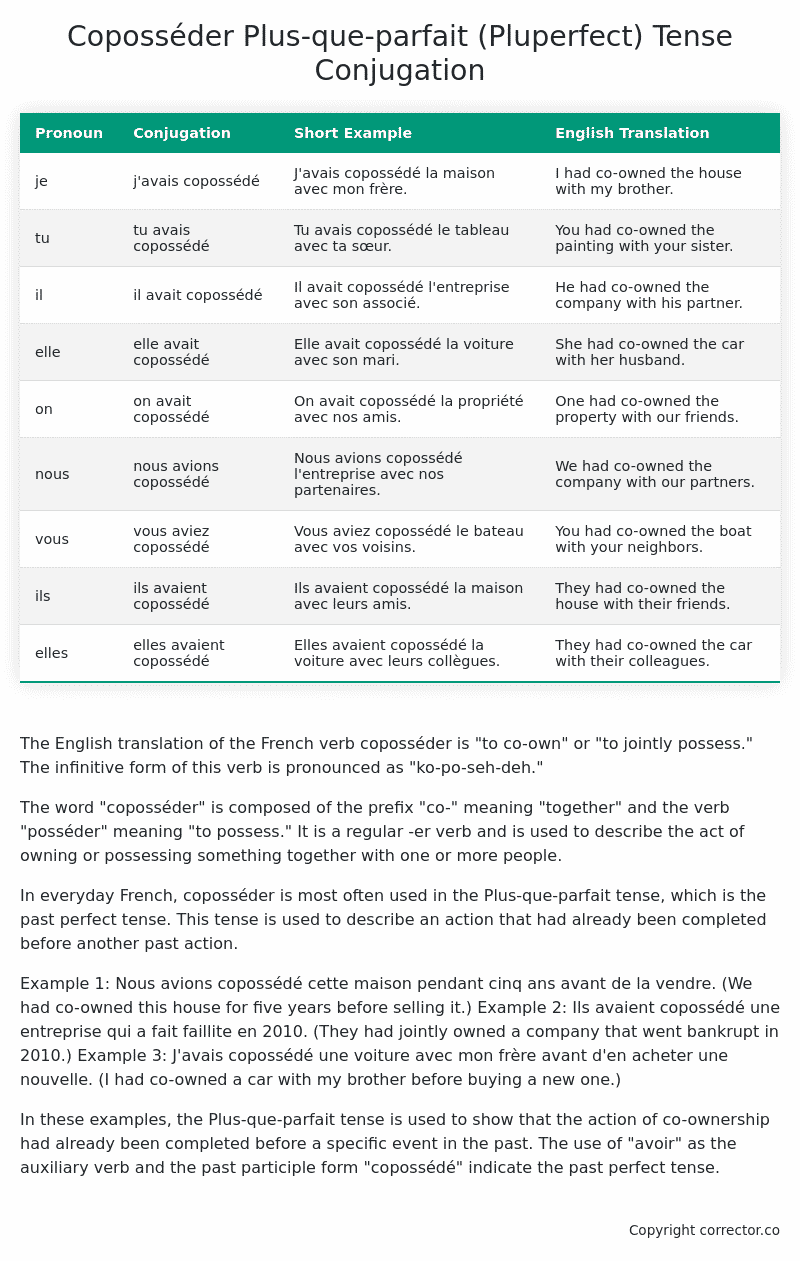Plus-que-parfait (Pluperfect) Tense Conjugation of the French Verb coposséder
Introduction to the verb coposséder
The English translation of the French verb coposséder is “to co-own” or “to jointly possess.” The infinitive form of this verb is pronounced as “ko-po-seh-deh.”
The word “coposséder” is composed of the prefix “co-” meaning “together” and the verb “posséder” meaning “to possess.” It is a regular -er verb and is used to describe the act of owning or possessing something together with one or more people.
In everyday French, coposséder is most often used in the Plus-que-parfait tense, which is the past perfect tense. This tense is used to describe an action that had already been completed before another past action.
Example 1: Nous avions copossédé cette maison pendant cinq ans avant de la vendre. (We had co-owned this house for five years before selling it.)
Example 2: Ils avaient copossédé une entreprise qui a fait faillite en 2010. (They had jointly owned a company that went bankrupt in 2010.)
Example 3: J’avais copossédé une voiture avec mon frère avant d’en acheter une nouvelle. (I had co-owned a car with my brother before buying a new one.)
In these examples, the Plus-que-parfait tense is used to show that the action of co-ownership had already been completed before a specific event in the past. The use of “avoir” as the auxiliary verb and the past participle form “copossédé” indicate the past perfect tense.
Table of the Plus-que-parfait (Pluperfect) Tense Conjugation of coposséder
| Pronoun | Conjugation | Short Example | English Translation |
|---|---|---|---|
| je | j’avais copossédé | J’avais copossédé la maison avec mon frère. | I had co-owned the house with my brother. |
| tu | tu avais copossédé | Tu avais copossédé le tableau avec ta sœur. | You had co-owned the painting with your sister. |
| il | il avait copossédé | Il avait copossédé l’entreprise avec son associé. | He had co-owned the company with his partner. |
| elle | elle avait copossédé | Elle avait copossédé la voiture avec son mari. | She had co-owned the car with her husband. |
| on | on avait copossédé | On avait copossédé la propriété avec nos amis. | One had co-owned the property with our friends. |
| nous | nous avions copossédé | Nous avions copossédé l’entreprise avec nos partenaires. | We had co-owned the company with our partners. |
| vous | vous aviez copossédé | Vous aviez copossédé le bateau avec vos voisins. | You had co-owned the boat with your neighbors. |
| ils | ils avaient copossédé | Ils avaient copossédé la maison avec leurs amis. | They had co-owned the house with their friends. |
| elles | elles avaient copossédé | Elles avaient copossédé la voiture avec leurs collègues. | They had co-owned the car with their colleagues. |
Other Conjugations for Coposséder.
Le Present (Present Tense) Conjugation of the French Verb coposséder
Imparfait (Imperfect) Tense Conjugation of the French Verb coposséder
Passé Simple (Simple Past) Tense Conjugation of the French Verb coposséder
Passé Composé (Present Perfect) Tense Conjugation of the French Verb coposséder
Futur Simple (Simple Future) Tense Conjugation of the French Verb coposséder
Futur Proche (Near Future) Tense Conjugation of the French Verb coposséder
Plus-que-parfait (Pluperfect) Tense Conjugation of the French Verb coposséder (this article)
Passé Antérieur (Past Anterior) Tense Conjugation of the French Verb coposséder
Futur Antérieur (Future Anterior) Tense Conjugation of the French Verb coposséder
Subjonctif Présent (Subjunctive Present) Tense Conjugation of the French Verb coposséder
Subjonctif Passé (Subjunctive Past) Tense Conjugation of the French Verb coposséder
Subjonctif Imparfait (Subjunctive Imperfect) Tense Conjugation of the French Verb coposséder
Subjonctif Plus-que-parfait (Subjunctive Pluperfect) Tense Conjugation of the French Verb coposséder
Conditionnel Présent (Conditional Present) Tense Conjugation of the French Verb coposséder
Conditionnel Passé (Conditional Past) Tense Conjugation of the French Verb coposséder
L’impératif Présent (Imperative Present) Tense Conjugation of the French Verb coposséder
L’infinitif Présent (Infinitive Present) Tense Conjugation of the French Verb coposséder
Struggling with French verbs or the language in general? Why not use our free French Grammar Checker – no registration required!
Get a FREE Download Study Sheet of this Conjugation 🔥
Simply right click the image below, click “save image” and get your free reference for the coposséder Plus-que-parfait tense conjugation!

Coposséder – About the French Plus-que-parfait (Pluperfect) Tense
Tense Formation
Common everyday usage patterns
Sequencing of past events
Background information
Hypothetical or reported speech
Interactions with other tenses
Summary
I hope you enjoyed this article on the verb coposséder. Still in a learning mood? Check out another TOTALLY random French verb conjugation!


